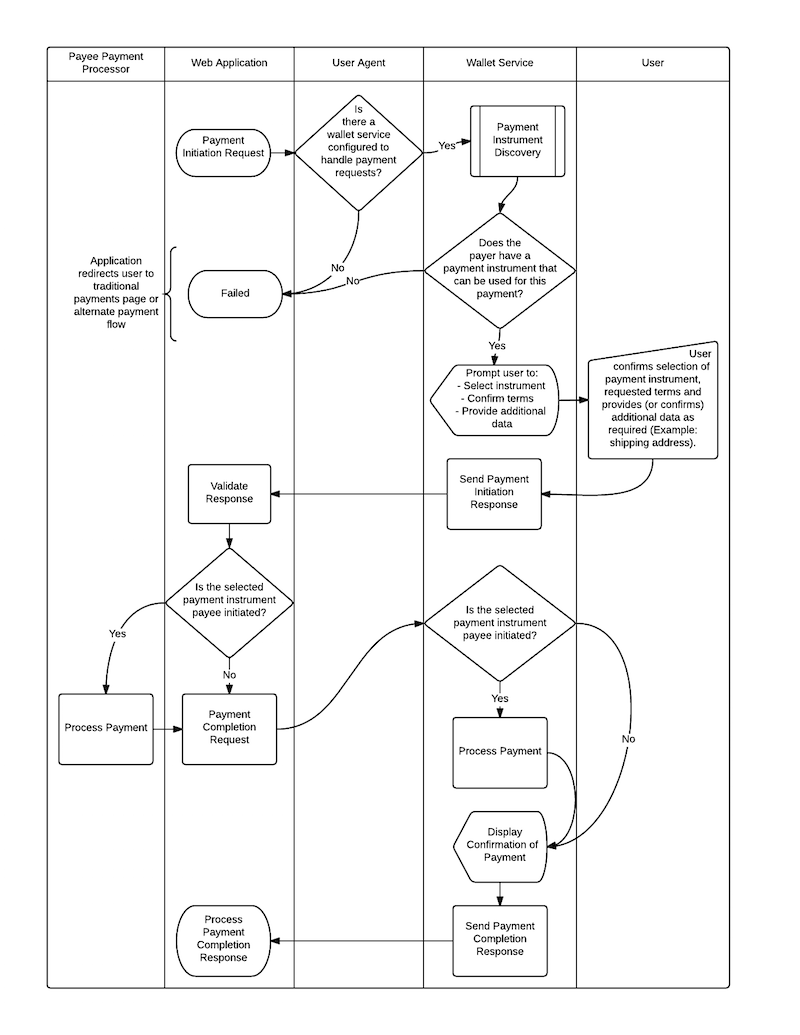Web Payments Phase 1
The initial implementation of the Web Payments work will start in October 2015
and will focus on delivering standards for a Minimum Viable Platform (MVP)
by December 2017.
Goals
The scope of work supports the following elements of a basic purchase
triggered by user interaction with a Web application initiating a new
payment. These standards define a high-level message flow for a payment
from payer to payee either in the form of a credit push (payer
initiated) or a debit pull (payee initiated) payment, and can be used to
facilitate a payment from any payment scheme.

- Pre-Payment
-
- Registration, by the payer with their
wallet, of any conforming payment
instrument they wish to use on the Web (e.g. a credit or
debit card, electronic cash, cryptocurrency, etc).
- Negotiation of Terms
-
- Payment Initiation Request, by the payee to
the payer providing the terms of the payment including elements
such as the accepted payment schemes, price, currency, recurrence,
transaction type (purchase, refund etc.), timeout and requests for
any additional data that is required from the payee.
- Negotiation of Payment Instruments
-
- Discovery, by the payer, of their available
payment instruments that can be used to make the payment. This is
done by matching those registered by the payer with those
supported by the payee (as defined in the Payment Initiation
Request), while keeping information local to the payer.
- Selection of a payment instrument by the
payer, confirmation of the terms, and sending of any requested
data back to the payee for validation.
- Payment Processing and Completion
-
- Execution of the payment by either payer or payee.
- Delivery of a Payment Completion generated by
the entity that executed the payment. This may contain a
Proof of Payment if supported by the payment
scheme.
The group will also address exceptions that may occur during these
steps, including payment authorization failure.
Use Cases
The following use cases are in scope for phase 1 with specific limitations
expressed beside each use case:
The capabilities associated with each use case listed above can be found in
the
Web Payments Capabilities 1.0 document.
Groups and Scope
A list of relevant groups that will participate in the first iteration of
specification creation.
| Group |
Scope |
Charter |
|
Web Payments Interest Group
|
Continued development of use cases and requirements for phase 2.
Liason between larger W3C community and other relevant standards bodies.
|
October 2014 - December 2017
|
|
Web Payments Working Group
|
Invoking a payment request, selecting a payment instrument, initiating funds
transfer, delivering a proof of payment.
|
Draft Charter
|
|
Web Authentication Working Group
|
Secure authentication of entities (users, systems and devices) to enable
high-security Web applications. Based on FIDO Alliance work.
|
No charter yet
|
|
Hardware-based Security Working Group
|
A set of Hardware-Based Web Security standard services providing Web
Applications usage of secure services enabled by hardware modules
(Trusted Execution Environments, Secure Elements, and other secure enablers).
|
No charter yet.
|
It is currently unknown whether or not a Credentials WG or Linked Data
Security WG will be created.
Related W3C Groups
-
Technical Architecture Group (TAG) (for reviews related to Web Architecture)
-
Security IG (for reviews about security)
-
Privacy IG (for reviews about sharing of sensitive information)
Related W3C Community Groups
-
Credentials
-
Web NFC
-
Web Payments
-
Web Bluetooth
-
Web Crypto API
-
Web of Things
Deployment and Adoption
Deployment in phase 1 will focus on enabling a few major online retailers
to run Web Payment agents to issue Web Payment invoices for processing at
1-2 major online Payment Service Providers (or banks). The payment
institutions would then initiate the payment and send a proof of payment
back to the retailer.
Goals
-
3 major online retailers launching Web Payments support (for example:
Alibaba, Walmart, Target, Best Buy, Overstock.com, Amazon, Tesco, eBay, etc.)
-
1-2 large online payment companies (or banks) launching Web Payments support
(for example: Google Wallet, PayPal, Alipay, Bank of America, HSBC,
US Fed, etc.)
-
5-10 smaller players from the online retail space and the payments space
-
1 million payments within the first year after standardization
-
Favorable reviews by the Web developer community
Strategies
-
Deployment strategy should be a pure software deployment. Do not require new hardware to be deployed.
-
Specifications should focus on technology that has already been prototyped.
-
All software should be cloud-only for phase 1. For example, do not try to
support both cloud and local wallets due to a possible conflict around the
"payment message bus" being implemented at the OS layer or the browser layer.
Unresolved Issues
Where we need an extensible message format, we will want to specify at least
a data model. The hard question will be whether we can achieve a single
serialization (e.g., JSON or JSON-LD or XML) or whether we need multiple.
What canonicalization (if any) is needed in our messages for the purpose of
digital signatures.
